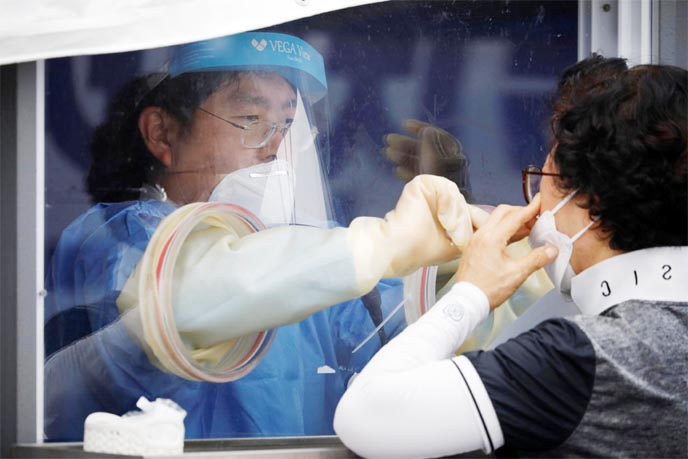
Reuters, Seoul :
South Korea recorded its 16th consecutive day of triple digit rises in new coronavirus cases on Saturday, extending a second wave of infections that is fanning concerns about a shortage of hospital beds in Seoul.
The Korea Centers for Disease Control and Prevention (KCDC) posted 308 new cases as of midnight Friday, the majority of them in the capital and surrounding areas.
Outbreaks have continued to erupt at churches, offices, nursing homes and medical facilities, even after officials tightened social-distancing rules.
The spike in cases has depleted hospital facilities, with the health ministry reporting that just 4.5% of beds in greater Seoul were available for critical cases as of Friday, down from 22% a week earlier.
“Only about 15 beds are immediately available in the greater Seoul area for patients in critical condition as there were numerous patients who were in a serious condition and needed to be hospitalised,” Yoon Tae-ho, director general for public health policy at the health ministry, said on Saturday.
“But we should have a little more room shortly because more people are being released,” he told a news briefing.
The KCDC said that more than 1,000 cases have been traced to the Sarang Jeil Church in Seoul, which is at the centre of the new wave of infections. Its head, Rev. Jun Kwang-hoon, is an outspoken government critic who was also confirmed to have contracted the virus.
The church outbreak led to at least 25 new clusters, and more than 300 people who joined an anti-government protest this month together with church members have tested positive so far, according to the KCDC.
The resurgence in cases has brought the country’s total reported COVID-19 cases to 19,400, including 321 deaths.
Dealing with the second wave of infections has been complicated by an ongoing strike of almost 16,000 intern and resident doctors.
South Korea recorded its 16th consecutive day of triple digit rises in new coronavirus cases on Saturday, extending a second wave of infections that is fanning concerns about a shortage of hospital beds in Seoul.
The Korea Centers for Disease Control and Prevention (KCDC) posted 308 new cases as of midnight Friday, the majority of them in the capital and surrounding areas.
Outbreaks have continued to erupt at churches, offices, nursing homes and medical facilities, even after officials tightened social-distancing rules.
The spike in cases has depleted hospital facilities, with the health ministry reporting that just 4.5% of beds in greater Seoul were available for critical cases as of Friday, down from 22% a week earlier.
“Only about 15 beds are immediately available in the greater Seoul area for patients in critical condition as there were numerous patients who were in a serious condition and needed to be hospitalised,” Yoon Tae-ho, director general for public health policy at the health ministry, said on Saturday.
“But we should have a little more room shortly because more people are being released,” he told a news briefing.
The KCDC said that more than 1,000 cases have been traced to the Sarang Jeil Church in Seoul, which is at the centre of the new wave of infections. Its head, Rev. Jun Kwang-hoon, is an outspoken government critic who was also confirmed to have contracted the virus.
The church outbreak led to at least 25 new clusters, and more than 300 people who joined an anti-government protest this month together with church members have tested positive so far, according to the KCDC.
The resurgence in cases has brought the country’s total reported COVID-19 cases to 19,400, including 321 deaths.
Dealing with the second wave of infections has been complicated by an ongoing strike of almost 16,000 intern and resident doctors.

